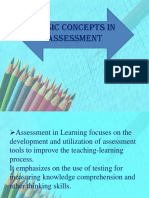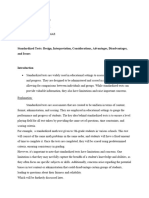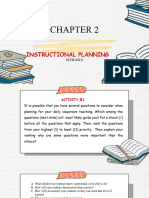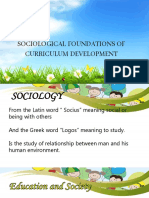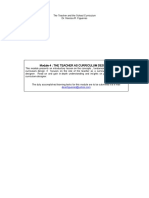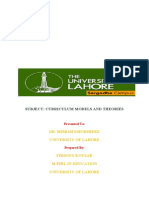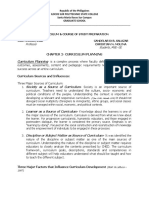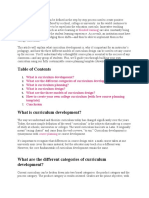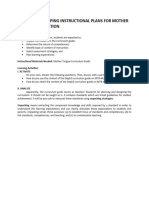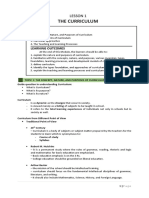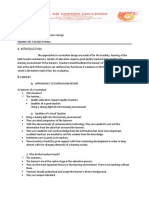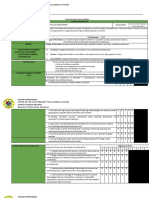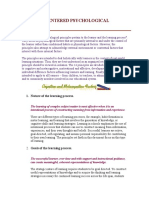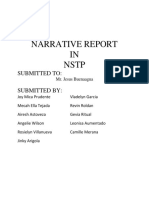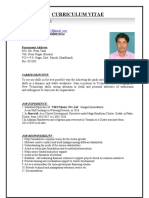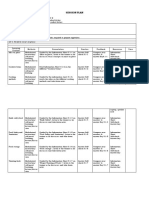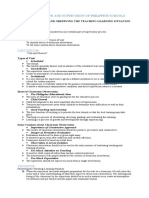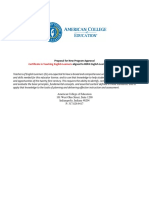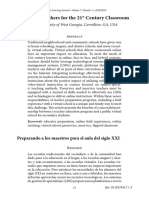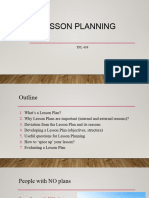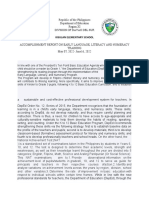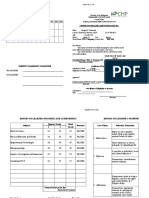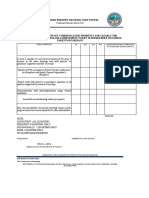04/12/2022, 15:02 # AY2022-23 S1-AS3&AS4 | ED 319: THE TEACHER AND THE SCHOOL CURRICULUM (UV MAIN: BSED3-A1) - https://acces…
Home
# AY2022-23 S1-AS3&AS4 | ED 319: THE TEACHER AND THE SCHOOL CURRICULUM (UV MAIN: BSED3-A1)
MODULE 1: THE TEACHER AND CURRICULUM ESSENTIALS
LESSON 5: CURRICULUM DEVELOPMENT: PROCESSES AND MODELS
Curriculum Development Process
Curriculum is a dynamic process involving many different people and procedures. Development connotes changes which is systematic. A change for the better means
alteration, modification, or improvement of existing condition.
To produce positive changes, development should be purposeful, planned and progressive. Usually it is linear and follows a logical step-by-step fashion involving the
following phases: curriculum planning, curriculum design, curriculum implementation and curriculum evaluation.
1. CURRICULUM PLANNING considers the school vision, mission and goals. It also includes the philosophy of strong education belief of the school. All of these
will eventually be translated to classroom desired learning outcomes for the learners.
2. CURRICULUM DESIGNING is the way curriculum is conceptualized to include the selection and organization of the content, the selection and organization of
learning experiences or activities and the selection of the assessment procedure and tools to measure achieved learning outcomes. A curriculum design will also
include the resources to be utilized and the statement of the intended learning outcomes.
3. CURRICULUM IMPLEMENTING is putting into action the plan which is based on the curriculum design in the classroom setting or the learning environment.
The teacher is the facilitator of learning and, together with the learners, uses the curriculum as design guides to what will transpire in the classroom with the end in
view of achieving the intended learning outcomes. Implementing the curriculum is where action takes place. Implementing the curriculum is where action takes place.
It involves the activities that transpire in every teacher‟s classroom where learning becomes an active process.
4. CURRICULUM EVALUATING determines the extent to which the desired outcomes have been achieved. This procedure is on-going as in finding out the progress
of learning (formative) or the mastery of learning (summative). Along the way, evaluation will determine the factors that have hindered or supported the
implementation. It will also pinpoint where improvement can be made and corrective measures, introduced. The result of evaluation is very important for decision
making of curriculum planners, and implementors.
CURRICULUM PROCESS MODELS
1. Ralph Tyler’s Model
Four Basic Principles/ Tyler’s Rationale
He posited four fundamental questions/principles in examining any curriculum in schools.
1. What educational purposes should the school seek
to attain?
2. What educational experiences can be provided that
are likely to attain these purpose?
3. How can these educational experiences be
effectively organized?
4. How can we determine whether these purposes are
being attained or not?
Tyler's Model shows that curriculum development, the following considerations should be made:
1 Purposes of the school
2. Educational experiences related to the purpose
3. Organization of the experiences
4. Evaluation of the experience
2. Hilda Taba
Linear Model / Grassroots Approach
She improved Tyler’s Rationale by making a linear model. She believed that teachers who teach or implement the curriculum should participate in developing it. She
presented seven major steps to her model where teachers could have major input.
https://access.uv.edu.ph/student_lesson/show/3666276?lesson_id=16887809§ion_id=64184574 1/3
�04/12/2022, 15:02 # AY2022-23 S1-AS3&AS4 | ED 319: THE TEACHER AND THE SCHOOL CURRICULUM (UV MAIN: BSED3-A1) - https://acces…
1. Diagnose of learner’s needs and
expectations of the larger society.
2. Formulations of learning
objectives.
3. Selection learning content.
4. Organization of learning content.
5. Selection of learning experiences
6. Organization of learning
activities
7. Determination of what to
evaluate
3. Galen Saylor and William Alexander Curriculum Model (1974)
They viewed curriculum development as consisting of four steps. Curriculum is “a plan for providing sets of learning opportunities to achieve broad educational goals and
related specific objectives for an identifiable population served by a single school center.
1. Goals, Objectives and Domains.
Curriculum planners begin by specifying the
major educational goals and specific
objectives they wish to accomplish. Each
major goal represents a curriculum domain:
personal development, human relations,
continued learning skills and specialization.
2. Curriculum Designing. Designing a
curriculum follows after appropriate
learning opportunities are determined and
how each opportunity is provided.
3. Curriculum implementation. a designed
curriculum is now ready for
implementation. Teachers then prepare
instructional plans where instructional
objectives are specified and appropriate
teaching methods and strategies are utilized
to achieve the desired learning outcomes
among students.
4. Evaluation. The last step of the
curriculum model is evaluation. A
comprehensive evaluation using a variety of
evaluation techniques is recommended. It
should involve the total educational
programme of the school and the curriculum
plan, the effectiveness of instruction and the
achievement of students. Through the
evaluation process, curriculum planner and
developers can determine whether or not the
goals of the school and the objectives of
instruction have been met.
Through the evaluation process, curriculum planner and developers can determine whether or not the goals of the school and the objectives of instruction have been met. All
the models utilized the process of (1) curriculum planning, (2) curriculum designing, (3) curriculum implementing, and (4) curriculum evaluating.
4. Hunkins’s Decision-making Model
In this model, Hunkins emphasized that curriculum is dynamic and that planners must not only consider diagnosis as the base and the evaluation as the summit of the
process. This model has also 7 steps which are as follows:
1. curriculum conceptualization and legitimization
2. curriculum diagnosis
3. curriculum development content selection
4. curriculum development experience selection
5. curriculum implementation
https://access.uv.edu.ph/student_lesson/show/3666276?lesson_id=16887809§ion_id=64184574 2/3
�04/12/2022, 15:02 # AY2022-23 S1-AS3&AS4 | ED 319: THE TEACHER AND THE SCHOOL CURRICULUM (UV MAIN: BSED3-A1) - https://acces…
6. curriculum evaluation
7. curriculum maintenance
5. Wiggins and McTighe Backward Design Model
The backward design is popularized by Wiggins and Mc Tighe in 2004. Curriculum design, under the understanding by design (UbD) framework begins with the
identification of desired results. Thereafter, one determines the acceptable evidence of learning and ends with planning the learning experiences and results.
UbD applied in Lesson planning
I. Explore
– Diagnose.
– Activate prior knowledge.
– Clarify expectations and how learning shall be assessed: standards; products/performances; criteria, tools.
– Hook and engage student interest
II. FIRM UP
The teacher shall:
• Provide a variety of learning resources
• Provide a variety of differentiated activities
• Encourage students to reflect, revise, or rethink their understanding • Check for understanding; provide feedback; check against content standard
III. Deepen
– Provide a variety of learning resources and differentiated activities/learning experiences in similar contexts to further validate student understanding.
– Encourage students to reflect, rethink, revise their understanding.
– Have students express their understanding
– Check for mastery ; provide feedback; check against content standard.
IV. Transfer
– Provide for transfer of learning to a new or different context.
– Evaluate product/performance; check against performance standard.
6. The Deliberation Model
True to its name, this model acknowledges the need to involve the stakeholders in curriculum planning. The comments and positions obtained during deliberations are
important inputs in designing the curriculum. The steps consist of:
Public Sharing. An educational group must come together and discuss what needs to be
Highlighting Agreement and Disagreements. The education group must highlight what they have in common and also what they differ in
Explaining The members of the group will take the information from the previous phases and make clear the various positions.
Highlighting Changes in Position. Educators make known any change in position. 5.Negotiating Points of Agreement. This part engages the participants in searching
for solutions. 6.Adopting a Decision. It is in this part that the individuals working together achieve
7. Concerns-based Adoption Model (CAM)
In this model, the core are the various concerns that are projected in each of the elements of curriculum designing. Designers and implementers of curriculum have to be
perceptive to address the relevant arguments that affect the quality of teaching and learning. These concerns consist of the awareness of innovation, awareness of
information level, concern for self, concern for teaching, and concern for students.
8. Innovation Configuration (IC)
The IC model supports the CAM as it centers on the expressed concerns: the awareness of innovation. The steps are as follows:
1. Ask the developer about intended components and emphases
2. Interview and observe a small number of users
3. Refine interview questions, interview a large number of users
4. Construct an IC checklist and use it with a number of users
5. Analyze the checklist data to identify dominant configurations
6. Use the data to provide appropriate development or in-service activities
https://access.uv.edu.ph/student_lesson/show/3666276?lesson_id=16887809§ion_id=64184574 3/3



